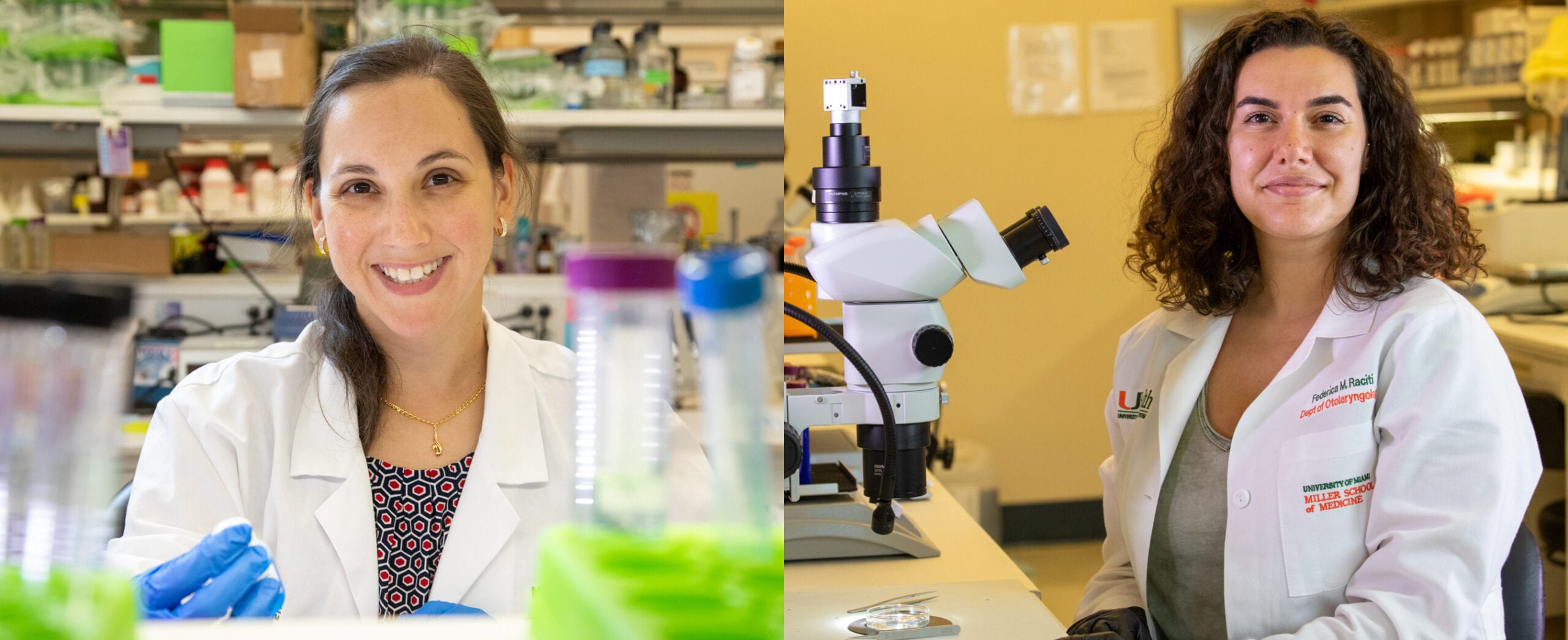The National Institutes of Health (NIH) Outstanding Scholars in Neuroscience Award Program (OSNAP) is designed to recognize and support those who are conducting exceptional neuroscience research across the nation and have great academic potential in their scientific training. The OSNAP is sponsored by the National Center for Advancing Translational Sciences (NCATS), the National Eye Institute (NEI) the National Institute on Deafness and Other Communication Disorders (NIDCD), the National Institute of Dental and Craniofacial Research (NIDCR), the National Institute of General Medical Sciences (NIGMS), the National Institute of Mental Health (NIMH), and the National Institute of Neurological Disorders and Stroke (NINDS). The Miami Project is fortunate this year to have two NIH Outstanding Scholars in Neuroscience Awardees, a testament to the talented young researchers studying under our Principal Investigators.
Federica Raciti is one of the award winners and is working on her thesis under the tutelage of Suhrud M. Rajguru, Ph.D., Co-Director, Institute for Neural Engineering, Associate Professor, Biomedical Engineering & Otolaryngology, The Miami Project to Cure Paralysis, Assistant Director, University of Miami CTSI Team Science.
Prior to moving to Miami, Federica went to the University of Milan in Italy where she received both her Bachelor and Master of Science in Biotechnology. Her earliest research experience in the world of neuroscience looked at the pathophysiology of glioblastoma cancer stem cells in the laboratory of molecular physiology of transport in Milan. After her years in Milan, she realized that she wanted to continue her education studying the physiology of the brain. Dr. Michele Mazzanti, her principal investigator at the time, helped her identify the University of Miami as an excellent place to continue her education in the neurosciences. In 2017, she was accepted in the graduate program of Cellular Physiology and Molecular Biophysics where she had the opportunity to rotate into Dr. Rajguru’s lab. It was at that time that it became obvious to her that she was extremely interested in the research aspect, but also the interdisciplinary environment Dr. Rajguru created in his lab.
“Dr. Rajguru’s mentorship has helped me grow leaps and bounds as a scientist. For the last three years, I have focused my work to expand the utility of the infrared neural stimulation technique to the vestibular system. The main goal of my thesis work is to lay the framework for the development of novel tools able to accurately mimic natural vestibular signals. This will provide improved interventions for people suffering from balance disorders,” said Raciti. She continued, “while I am extremely proud to be a recipient, this award is the culmination of an inspired research project, a great training environment, and a devoted mentor.”
“This Outstanding Scholars in Neuroscience award and the recognition from the NIH is very well-deserved for Federica who is a promising, young scientist. Over the past 3 years, I have truly enjoyed mentoring and guiding Federica in her research. With her preparedness, critical thinking skills, and a detailed approached designing and executing experiments, I have no doubt that she has a bright future ahead in the field of sensory neuroscience,” said Dr. Rajguru.
The next Outstanding Scholars in Neuroscience awardee is Madelen Diaz, Ph.D., a Postdoctoral Associate in Dr. Daniel Liebl’s Lab. Dr. Liebl is a Professor, Department of Neurological Surgery and The Miami Project to Cure Paralysis. Dr. Diaz received her Bachelor of Science in Neuroscience from the University of Miami and a Doctor of Philosophy in Neuroscience from Brandeis University. Her graduate advisor was Professor Michael Rosbash, who was awarded a Nobel Prize in Physiology and Medicine in 2017. In his lab, she investigated the neuronal circuitry that regulates circadian rhythms in Drosophila. She helped reveal how the molecular clock not only regulates day/night activity, but also affects neuronal plasticity and transmission. In reciprocal, this neuronal activity creates a feedback loop to regulate the molecular clock. This foundation in molecular neuroscience equipped Dr. Diaz with the skills to investigate key underlying mechanisms in a more translational field.
She chose Professor Liebl’s laboratory for her postdoctoral training because his research interests are well-aligned with her pursuit to learn about molecular and translational neuroscience in the context of neurological injury. Her graduate training consisted of a more “basic” molecular neuroscience approach with an emphasis on neuronal circuitries and behavior. Although she had high-quality training from her thesis advisor, and in the graduate program at Brandeis University, Dr. Diaz knew she wanted to enter the translational field of research to contribute to human health from injury and disease.
She mentioned while recalling the interview process prior to entering the Liebl Lab in the Spring of 2019, “I was highly impressed and enthralled with the holistic approaches the lab utilized to address their hypothesis in a recent manuscript submission. This was a major factor in me determining that the Liebl Lab was an excellent and nurturing environment to learn how to work within a novel model organism and research field, especially one as complex as TBI research.”
Dr. Diaz’s current research focuses on characterizing the molecular mechanisms of Dependence Receptor-mediated cell death after TBI. She presented her work at a recent Miami Project Seminar on the project. She is also examining the role of cholesterol homeostasis and trafficking in cellular stress after TBI.
The Miami Project and the University of Miami are fortunate to continue to draw the best in upcoming talent in the neuroscience research field. Training the next generation of neuroscientists, with the goal of hastening cures and treatments, has been a large part of The Miami Project’s mission. These two researchers join a log and distinguished list of neuroscientists that have been a part of our comprehensive team over the last three and a half decades.

